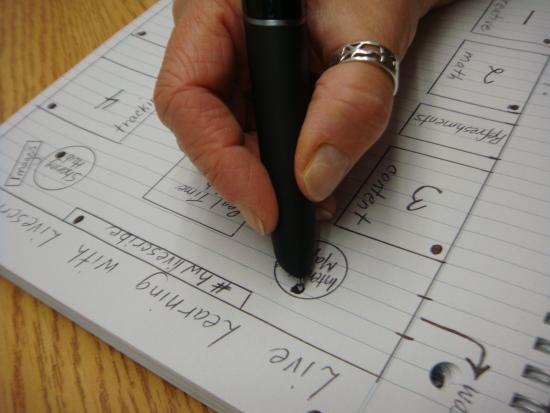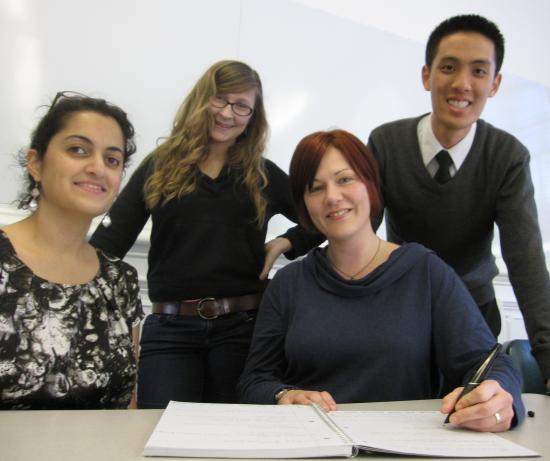When the UC Berkeley Disabled Students Program started a pilot test providing Livescribe computerized pens to students with learning disabilities, I School students volunteered to evaluate whether the pens could improve student learning and substitute for companion notetakers.
“Initially, the DSP was hoping that the use of the pen would lessen the students’ reliance on hired notetakers,” explained Christen Penny, an I School student on the evaluation team. “But our research showed that it’s more complicated than that.”
The Disabled Students Program arranged with School of Information professor Nancy Van House to recruit students from her graduate-level user experience research course, Information 214, which connects graduate students with real-world technology users for the class evaluation project.
The evaluation team included Penny, now a second-year MIMS student; Lindsay Baker, an architecture Ph.D. student; Kevin Huang, a master’s student in mechanical engineering; and Aditi Rao, a recent graduate from Berkeley’s architecture and city planning departments.
Forty students with a variety of physical and learning disabilities participated in the DSP’s pilot program and were provided with a Livescribe Echo smartpen for taking class notes. The smartpen records audio from the class along with a digital version of the student’s handwritten notes, syncing the two; audio and notes can then be accessed for review through either the pen itself or through Livescribe’s computer software.
Reduced classroom anxiety
The evaluation revealed several interesting insights into the smartpen. Although the study was too short to determine whether students’ grades improved, another finding was particularly striking — the new sense of confidence that the smartpen seemed to provide. Many of the students reported that the pen reduced their classroom anxiety and freed them up to pay better attention.
“When I miss something, it creates an enormous amount of anxiety for me,” explained one pilot test participant who suffers from anxiety and ADD. “When you’re trying to learn, suffering from anxiety is really not good!” Another student referred to the pen as her “back-up ears”; when she uses the pen to record lectures, she doesn’t have to worry about missing important information, she said.
“I was surprised by the results,” said Penny. “Even if the students didn’t go back and re-listen to the lectures, just knowing that they could go back helped them relax more in the classroom.”
Smartpen’s benefits depend on the details of the learning disability
The staff of the Disabled Students Program were excited by the students’ findings about which students are most likely to benefit from the pen. “We found that people used it in a lot of different ways, because they have lots of different learning styles,” explained Baker. How the students used the pen depended on the subject matter of the course, as well the student’s specific notetaking and study strategies.
One student would go back and rewrite the notes he had taken in class, while re-listening to the lecture recording. Another participant with a physical disability limiting his fine motor control found the pen especially useful; his notetaking is restricted to writing a single word to describe each part of the lecture. He could then use the pen to replay just the section of the audio recording associated with each of his keywords. “The benefits they got from the pen really depended on the details of their learning disability,” concluded Rao.
“By talking to students about their experiences, the evaluation revealed this key decision point about when to use the pen and when not to use the pen,” said Paul Hippolitus, the director of the Disabled Students Program. Students who learn by listening can benefit from relistening to the pen’s audio recording outside of the commotion of the classroom. On the other hand, students who have an auditory-processing problem and learn best by reading are unlikely to benefit from the pen; “No matter how many times they listen to the recording, the pen doesn’t overcome their functional limitation,” said Hippolitus.
The Disabled Students Program is now expanding its use of the Livescribe pens with students with disabilities, based in part on the study’s findings. “What the team has accomplished with their evaluation has already caused a stir in the field — a good one,” said Hippolitus. “The other UC directors of disabled students programs will likewise have questions for the team, as they are closely watching our efforts with the pen.” The DSP is implementing additional recommendations from the team’s evaluation for training and orienting new users of the pen.
After the completion of the evaluation, the team also met with the CEO of Livescribe, the pen manufacturer, to discuss their findings and recommend software and design improvements that could benefit users with disabilities.
Not just an exercise
Professor Van House is gratified to see the impact that her user-experience course is having outside the classroom walls. “User-centered practices are particularly important when designing for people with disabilities,” said Van House. “As researchers or technologists, we can’t assume that our experiences are the same as our users’. This is even more true when users have physical or mental disabilities.” The course teaches research techniques like ethnographic observation, interviews, surveys, and focus groups, along with methods of bringing user experience research into the design process.
Van House encourages her students to apply the course’s user experience research methods beyond the traditional desktop computing environment. And the students appreciated that their coursework could provide people a real-life benefit. “I was really impressed by how much the I School works with real projects,” said team member Lindsay Baker. “In a lot of courses, we just do exercises, but this class wasn’t just an exercise. That was really exciting.”











